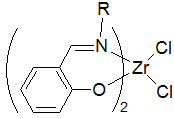Post-metallocene catalystA post-metallocene catalyst is a kind of catalyst for the polymerization of olefins, i.e., the industrial production of some of the most common plastics. "Post-metallocene" refers to a class of homogeneous catalysts that are not metallocenes. This area has attracted much attention because the market for polyethylene, polypropylene, and related copolymers is large. There is a corresponding intense market for new processes as indicated by the fact that, in the US alone, 50,000 patents were issued between 1991-2007 on polyethylene and polypropylene.[1] Many methods exist to polymerize alkenes, including the traditional routes using Philips catalyst and traditional heterogeneous Ziegler-Natta catalysts, which still are used to produce the bulk of polyethylene. Catalysts based on early transition metals
Homogeneous metallocene catalysts, e.g., derived from or related to zirconocene dichloride introduced a level of microstructural control that was unavailable with heterogeneous systems.[2] Metallocene catalysts are homogeneous single-site systems, implying that a uniform catalyst is present in the solution. In contrast, commercially important Ziegler-Natta heterogeneous catalysts contain a distribution of catalytic sites. The catalytic properties of single-site catalysts can be controlled by modification of the ligand. Initially ligand modifications focused on various cyclopentadienyl derivatives, but great diversity was uncovered through high throughput screening. These post-metallocene catalysts employ a range of chelating ligands, often including pyridine and amido (R2N−). These ligands are available in great diversity with respect to their steric and electronic properties. Such postmetallocene catalysts enabled the introduction of Chain shuttling polymerization.[1] Catalysts based on late transition metalsThe copolymerization of ethylene with polar monomers has been heavily studied. The high oxophilicity of the early metals precluded their use in this application.[3]
Efforts to copolymerize polar comonomers led to catalysts based upon nickel and palladium, inspired by the success of the Shell Higher Olefin Process. Typical post-metallocene catalysts feature bulky, neutral, alpha-diimine ligands.[3] DuPont commercialized the Versipol olefin polymerization system.[5] Eastman commercialized the related Gavilan technology.[6] These complexes catalyze the homopolymerize ethylene to a variety of structures that range from high density polyethylene through hydrocarbon plastomers and elastomers by a mechanism referred to as “chain-walking”. By modifying the bulk of the alpha-diimine, the product distribution of these systems can be 'tuned' to consist of hydrocarbon oils (alpha-olefins), similar to those produced by more tradition nickel(II) oligo/polymerization catalysts. As opposed to metallocenes, they can also randomly copolymerize ethylene with polar comonomers such as methyl acrylate. A second class of catalysts feature mono-anionic bidentate ligands related to salen ligands.[7] and DuPont.[8][9] The concept of bulky bis-imine ligands was extended to iron complexes[3] Representative catalysts feature diiminopyridine ligands. These catalysts are highly active but do not promote chain walking. The give very linear high-density polyethylene when bulky and when the steric bulk is removed, they are very active for ethylene oligomerization to linear alpha-olefins.[3] A salicylimine catalyst system based on zirconium exhibits high activity for ethylene polymerization.[10] The catalysts can also produce some novel polypropylene structures.[11] Despite intensive efforts, few catalysts have been successfully commercialized for the copolymerization of polar monomers. References
|



![Catalyst supported by highly electron-withdrawing substituted ligand.[4]](http://upload.wikimedia.org/wikipedia/commons/thumb/1/1b/Trippy-nickel-catalyst.png/250px-Trippy-nickel-catalyst.png)















